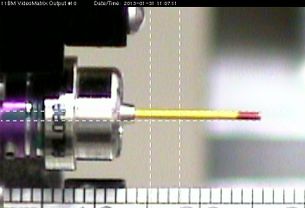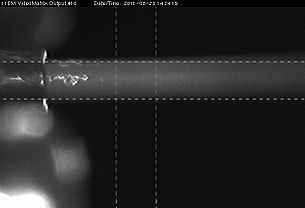Difference between revisions of "Mail-In Powder Diffraction Measurements"
| Line 7: | Line 7: | ||
Some mail-in samples may require additional glass or fused quartz capillary tubes nested inside the standard Kapton tube. Any additional capillary must fit and be secured inside the supplied Kapton tube. | Some mail-in samples may require additional glass or fused quartz capillary tubes nested inside the standard Kapton tube. Any additional capillary must fit and be secured inside the supplied Kapton tube. | ||
See the Wiki for [https://wiki-ext.aps.anl.gov/ug11bm/index.php/Nesting_Glass/Quartz_Capillaries_in_Kapton_Tubes Instructions on Nesting Capillaries]. | |||
This can be useful for samples which are: | This can be useful for samples which are: | ||
| Line 12: | Line 14: | ||
*X-ray Absorbing ([https://wiki-ext.aps.anl.gov/ug11bm/index.php/X-ray_Absorption_and_Fluorescence more info]) | *X-ray Absorbing ([https://wiki-ext.aps.anl.gov/ug11bm/index.php/X-ray_Absorption_and_Fluorescence more info]) | ||
'''Note:''' 11-BM does not provide glass or quartz capillaries for mail-in experiments. Only Kapton tubes (with an inner diameter of 0.81 mm) are provided for the mail-in service. See the Wiki for more info (vendors etc) on [https://wiki-ext.aps.anl.gov/ug11bm/index.php/Equipment_and_Tools#Capillaries:_Thin_Wall_Glass_and_Fused_Quartz glass or fused quartz capillaries]. | |||
Note: 11-BM does not provide glass or quartz capillaries for mail-in experiments. Only Kapton tubes (with an inner diameter of 0.81 mm) are provided for the mail-in service. See the Wiki for more info (vendors etc) on [https://wiki-ext.aps.anl.gov/ug11bm/index.php/Equipment_and_Tools#Capillaries:_Thin_Wall_Glass_and_Fused_Quartz glass or fused quartz capillaries]. | |||
== Image Gallery== | == Image Gallery== | ||
Revision as of 16:50, 30 May 2012
Nesting Capillaries inside Kapton Tubes
Some mail-in samples may require additional glass or fused quartz capillary tubes nested inside the standard Kapton tube. Any additional capillary must fit and be secured inside the supplied Kapton tube.
See the Wiki for Instructions on Nesting Capillaries.
This can be useful for samples which are:
Note: 11-BM does not provide glass or quartz capillaries for mail-in experiments. Only Kapton tubes (with an inner diameter of 0.81 mm) are provided for the mail-in service. See the Wiki for more info (vendors etc) on glass or fused quartz capillaries.
Image Gallery
Two views of a sample in position for data-taking, as seen through the "upstream" camera (left) and the video microscope (right). The reticle lines show the nominal extent of the beam. The actual beam edges extend somewhat farther, so these areas should be kept clear of foreign material (glue, clay, wax, etc.). The sample material must be held in place in the beam -- if it is loose in the capillary, it will move when we spin the capillary (we spin at about 5400 r.p.m.). In addition, there must be no lumps of material at the end of the capillary, since this could cause the capillary to bend or break during spinning, and such a lump may also cause a robot malfunction when it attempts to load or unload the sample.
Tools
User may find some of the following tools helpful when preparing samples:
- Small Drill Bits can be useful for loading & packing powder inside Kapton tubes (more details)
- Powder Sieves help remove any large particles and ensure homogeneous powders (more details)
- Mortar & Pestles Agate mortars and pestles are invaluable tools for grinding powder samples (more details)

